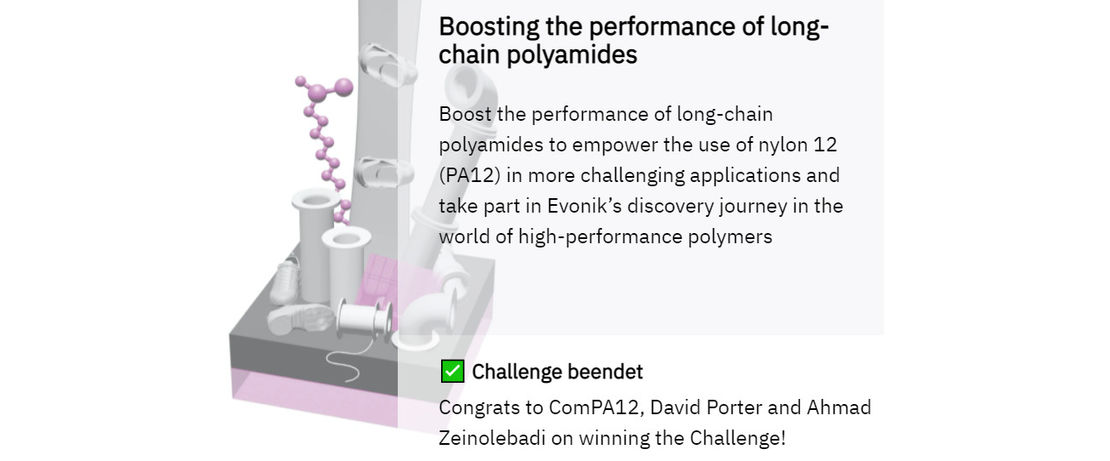
Challenge closed
Boosting the performance of long-chain polyamides
Boost the performance of long-chain polyamides to empower the use of nylon 12 (PA12) in more challenging applications and take part in Evonik’s discovery journey in the world of high-performance polymers
SUBMISSION WAS Feb. 8th, 2021
CHALLENGE CLOSED
The Challenge
Polyamide 12 (Nylon 12) was developed in the 1960ies by Chemiewerke Huels, a predecessor of Evonik, and is marketed under the tradename VESTAMID. Nylon 12 is used for automotive fuel and brake lines, oil and gas pipes, sport shoe soles, industrial coatings, and additive manufacturing.
TROGAMID CX is a transparent Polyamide of Evonik, which is based on a cycloaliphatic monomer and offers high transparency. It is used for sunglasses, water filters, or medical applications.
Long-chain polyamides such as Polyamide 12 convince with balanced properties towards mechanical and chemical stability as well as toughness at low temperatures but are limited in use in applications that require a high continuous use temperature (e.g. under the hood applications).
In this challenge Evonik wants to experience new concepts, with which the material performance can be boosted to offer new features, broaden the application field for this high-performance polymer, experience new processing technologies and learn about potential new use cases for nylon 12.
TRACKS
To participate in this challenge, you can use one of the following four tracks to help structure your approach and get a better understanding of the different areas that Evonik is focusing on.
- Stabilization against hydrolysis and thermal degradation: Which new stabilizer concepts (and suppliers thereof) are available to push the limitation of long-chain polyamides due to hydrolysis and thermal degradation? Which chemistry can be used for fiber-reinforced/ unreinforced materials and how can it be applied? Which applications can be addressed with a thermally more stable material?
- Track 2: Refractive Index Inspire us with new approaches to enhance the refractive index in transparent polyamides to at least 1,7! Propose additives systems and a suitable approach to incorporate them into the polymeric material. Which polymer modification at transparent polyamides is possible to influence the refractive index? Surprise us with new comonomers!
- Track 3: Compatibility and adhesion How can you modify nylon 12 to ensure adhesion to other polymers such as PVDF, PP or EVOH in multilayer processes without using additional adhesives? Which processes can be used to ensure proper adhesion?
- Track 4: Novel use cases for long-chain polyamides
Which use cases are possible with PA12 foams (particle or extruded foam, ideally flame retardant) as well as PA12 composites (GMTs, UD Tapes, organosheets, ….) that can bring additional value for the application. Think about creative use case (e.g. foams instead of bulk plastic or metal parts) and do not consider a simple replacement of existing materials in foam or composite applications?
Key Questions
The following questions should help you to find the right path for your participation and help you to have a better focus of what is asked for.
Non-Track Related Questions:
Which concepts from other polymers be directly transferred to PA12?
Which new applications can be potentially addressed after the implementation of your solution into PA12?
What are the limitations of your solution?
Is your solution (or anything similar) commercially available?
Which process is required to implement your solution?
Criteria
The evaluation criteria for the ECRP are defined as follows (ranking from 0 – 10, all criteria have the same weight):
Creativity:
The proposal is unknown to Evonik so far in the way that it shows a high degree of creativity and represents a new approach for Evonik from the research or application side
Probability of technical and commercial success:
There is a high chance of technical and commercial success to be expected if the proposed research concept can be successfully realized.
Quality of project proposal:
The project proposal is well explained and contains all information necessary to describe actual research status; all relevant documents are referenced; clear description of what is planned to be done, when and with which resources.
Open innovation & collaborative research approach:
There is a clear description of research groups, contractual partners and/or experts to be involved besides own research group and Evonik during the research project proposed
Each Submission should cover certain parameters that are key for their success:
There should be a detailed process parameter and process description
All detailed names of the used chemicals (incl. CAS number and potential supplier)
You should add drawings and examples as well as references for a comparable system or proposed solution
The benefits/limitations of your solution and potential collaboration partners for development and scaling up should be pointed out
